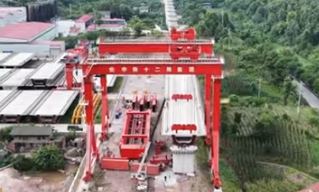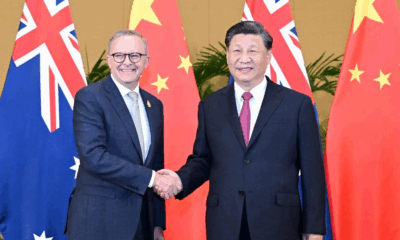Media
တရုတ်နိုင်ငံလုပ်ငန်းကုမ္ပဏီများက ဒါကာမြို့၌ ပထမဆုံးမိုးပျံ အမြန်လမ်းတည်ဆောက်
ဒါကာ၊ ဧပြီ ၂၈ ရက် (ဆင်ဟွာ)
ကမ္ဘာ့ လူဦးရေအထူထပ်ဆုံးမြို့များထဲတွင်တစ်မြို့အပါအဝင်ဖြစ်ပြီး ယာဉ်ကြောပိတ်ဆို့မှု အဆိုးဆုံး မြို့ထဲတွင်တစ်မြို့ဖြစ်သည့် ဘင်္ဂလားဒေ့ရှ်နိုင်ငံ၏မြို့တော် ဒါကာတွင် ပထမဆုံး ဒါကာ မိုးပျံ အမြန်လမ်း FDEE ကို တည်ဆောက်လျက်ရှိသည်။
ကီလိုမီတာ ၂၀ အရှည်ရှိသည့် အမြန်လမ်းအား ဘင်္ဂလားဒေ့ရှ်နိုင်ငံ ၏ အဓိက သယ်ယူပို့ဆောင်ရေး ပင်မလမ်းကြောင်းနှင့် ချိတ်ဆက်မှုမပြုခင် Hazrat Shahjalal နိုင်ငံတကာလေဆိပ် မှ ဒါကာမြို့လယ်ရှိ Kamalapur ရထားဘူတာသို့ ချိတ်ဆက်ဖောက်လုပ်မည်ဖြစ်သည်။
၂၀၁၁ ခုနှစ်တွင် ဘင်္ဂလားဒေ့ရှ်နိုင်ငံ လမ်းတံတားအာဏာပိုင်အဖွဲ့က အမြန်လမ်းတည်ဆောက်ရန် ပြည်ပ ဆောက်လုပ်ရေး ကုမ္ပဏီတစ်ခုနှင့် သဘောတူစာချုပ်လက်မှတ်ရေးထိုးခဲ့သည်။ ဆယ်စုနှစ်တစ်ခုနီးပါးအကြာ ၂၀၁၉ ခုနှစ်ကုန်ပိုင်းအထိ တိုးတက်မှုမရှိသေးသောကြောင့် အဆိုပါ တည်ဆောက်ရေးလုပ်ငန်းကို လမ်းတံတားအာဏာပိုင်များနှင့် တရုတ်နိုင်ငံမှ အစိုးရ-ပုဂ္ဂလိက လုပ်ငန်း ကုမ္ပဏီများ ဖြစ်သည့် Shandong Hi-Speed နှင့် SinoHydro တို့ လွှဲပြောင်းလုပ်ဆောင်ခဲ့သည်။
အကျိုးတူပူးပေါင်းဆောင်ရွက်ရေး လုပ်ငန်း ဘေးကင်းလုံခြုံရေးနှင့် ညှိနှိုင်းရေးမန်နေဂျာဖြစ်သူ MD BELAL HOSSAIN က“ဒီစီမံကိန်းဟာ ဒါကာမြို့မှာ သိပ်ကိုအရေးပါတဲ့ စီမံကိန်းတစ်ခုဖြစ်ပါတယ်၊ ဒါဟာ ဒါကာမြို့ရဲ့ ရထားလမ်းပေါ်မှာ တည်ဆောက်ထားတဲ့ ပထမဆုံးမိုးပျံအမြန်လမ်းဖြစ်ပါတယ်၊ COVID-19 ကပ်ရောဂါ ဖြစ်ပွား ချိန်မှာ အခြားစီမံကိန်းတွေနဲ့ အခြားစက်မှုလုပ်ငန်းတွေ ပိတ်သွားပေမဲ့ကျွန်တော်တို့ဆက်လက် လုပ်ဆောင်ခဲ့ပါတယ်။ အဓိက စိန်ခေါ်မှုတွေထဲက တစ်ခုကတော့ ကျွန်တော်တို့ဟာ ရထားလမ်းအပေါ်မှာ တည်ဆောက်ရမယ့်ကိစ္စဖြစ်ပါတယ်၊ အဲဒီလိုလုပ်ဆောင်တဲ့အခါမှာ အန္တရာယ်တွေနဲ့ စိန်ခေါ်မှုတွေ များစွာရှိပါတယ်၊ ကျွန်တော်တို့ရဲ့ ဦးတည်ချက်တွေထဲက တစ်ခု ကတော့ မတော်တဆ ထိခိုက်မှု လုံးဝ ကင်းစင်ရေးဖြစ်ပြီး အဲဒီ ဦးတည်ချက်ကို ပြည့်မီအောင်လုပ်ဆောင်နိုင်တုန်းပါပဲ၊ နောက်ပြီး ကျွန်တော်တို့ဟာ အဲဒီ ဦးတည်ချက်ကို ပြည့်မီနိုင်မယ်လို့မျှော်လင့်ပါတယ်” ဟုဆိုသည်။
တရုတ်လူမျိုး ပညာရှင်တစ်ဦးဖြစ်သူ FAN ZHANYIN က“ကျွန်တော် ဟာ ဘင်္ဂလားဒေ့ရှ်နိုင်ငံသားတွေနဲ့အလုပ်အတူလုပ်ရလို့သိပ်ကိုပျော်ရွှင်မိပါတယ်၊ ကျွန်တော် တို့ ဟာ အတူတကွကောင်းမွန်စွာ လုပ်ကိုင်ခဲ့ကြတာပါ၊ အနာဂတ်မှာ နှစ်နိုင်ငံက ပြည်သူတွေက လမ်းတွေ တံတားတွေကို ပိုမို အရည်အသွေးမြင့်မားစွာ ပိုမိုကောင်းမွန်စွာ တည်ဆောက်ဖို့ အတူတကွလုပ်ဆောင်နိုင်မယ်လို့ မျှော်လင့်ပါတယ်” ဟုဆိုသည်။
ဘင်္ဂလားဒေ့ရှ်နိုင်ငံမှ ကျွမ်းကျင်ပညာရှင် SAJJADUL KABIR က“ကျွန်တော့်အနေနဲ့ အခုလိုကြီးမားတဲ့ စီမံကိန်းတစ်ခုမှာ လုပ်ကိုင်ခွင့်ရလို့ သိပ်ကိုပျော်ရွှင်မိပါတယ်၊ တရုတ်နိုင်ငံက လုပ်ဖော်ကိုင်ဖက်တွေနဲ့လည်း ကျွန်တော် အများကြီးသင်ယူလေ့လာခဲ့ရပါတယ်၊ ကျွန်တော် ဒီမှာ အတွေ့အကြုံတွေ ရပါတယ်၊ ကျွန်တော်ဟာ အနာဂတ်မှာ နိုင်ငံက အခြား စီမံကိန်းကြီးတွေမှာလည်း လုပ်ကိုင်နိုင်မယ်လို့မျှော်လင့်ပါတယ်” ဟုဆိုသည်။
စီမံကိန်း၏ Banani အပိုင်း တည်ဆောက်ရေး ဒုတိယ ညွှန်ကြားရေးမှူးဖြစ်သူ ZOU BING က
“ ကျွန်တော်တို့ ဒေသခံ ဝန်ထမ်းပေါင်း ၂,၅၀၀ ကျော် ကို အလုပ်ခန့်ထားခဲ့ပြီး သူတို့အတွက် သင်တန်းတွေပို့ချပေးခဲ့ပါတယ်။ လက်ရှိမှာ ကျွန်တော်တို့ရဲ့ စီမံကိန်းဟာ လျှင်မြန်စွာတိုးတက်နေပါတယ်၊ စီမံကိန်း ဟာ ၂၀၂၃ ခုနှစ်မှာ အပြီးသတ်မယ်လို့မျှော်လင့်ရပါတယ်” ဟုဆိုသည်။
ကျိုး ၏ အဆိုအရ စီမံကိန်းပြီးစီးပါက အမြန်လမ်းမှာ ဒါကာမြို့အတွင်း ယာဉ်ကြောပိတ်ဆို့မှုကိုလျော့ပါးစေမည်ဖြစ်ပြီး ခရီးသွားလာရန် ကြာမြင့်ချိန် ကို ၃ နာရီမှ မိနစ် ၂၀ အထိ လျှော့ချပေးနိုင်မည်ဖြစ်ကြောင်း သိရသည်။ (Xinhua)
……………………………….
(English Version)
GLOBALink | Dhaka’s 1st elevated expressway construction gains Chinese impetus
The First Dhaka Elevated Expressway (FDEE) is being built in Bangladesh’s capital Dhaka, which is one of the world’s most densely populated capitals with some of the worst traffic jams.
The 20-km expressway runs from Hazrat Shahjalal International Airport to Dhaka’s central Kamalapur railway station, before connecting to the main transportation artery in Bangladesh.
In 2011, the Bangladesh Bridge Authority contracted an overseas construction company to build the expressway. Almost a decade later at the end of 2019, with no progress made, the deal was handed over to Chinese companies, Shandong Hi-Speed and SinoHydro in a public-private partnership with the bridge authority.
SOUNDBITE 1 (Bengali): MD BELAL HOSSAIN, Safety and coordination manager of the joint venture
“This is a very important project in Dhaka city. It is the first elevated expressway in Dhaka city over the railway line. During the COVID-19 outbreak, when other projects and other industries were closed down, we continued to work. One of the major challenges is that we will have to build a section over railway line. There are plenty of risks and challenges. One of our targets is zero accidents, and we are still on target to meet that goal. And we hope we can meet the target.”
SOUNDBITE 2 (Chinese): FAN ZHANYIN, Chinese technician
“I’m very happy to work with Bangladeshi people. We have a great time working together. I hope in the future, people from both countries can work together to build better roads and bridges, with high qualities.”
SOUNDBITE 3 (Bengali): SAJJADUL KABIR, Bangladeshi technician
“I’m very happy to be able to work in such a big project. I’m learning a lot of things from my Chinese colleagues. I’m gaining experience here. I hope in the future, I can work on other big projects in the country.”
SOUNDBITE 4 (Chinese): ZOU BING, Deputy construction director of the project’s Banani section
“We’ve recruited more than 2,500 local employees, and carried out training for them. Currently, our project is progressing rapidly. It is expected to be finished in 2023.”
According to Zou, when completed, the expressway will shorten the travel time from three hours to 20 minutes and ease the traffic in Dhaka.
Produced by Xinhua Global Service






